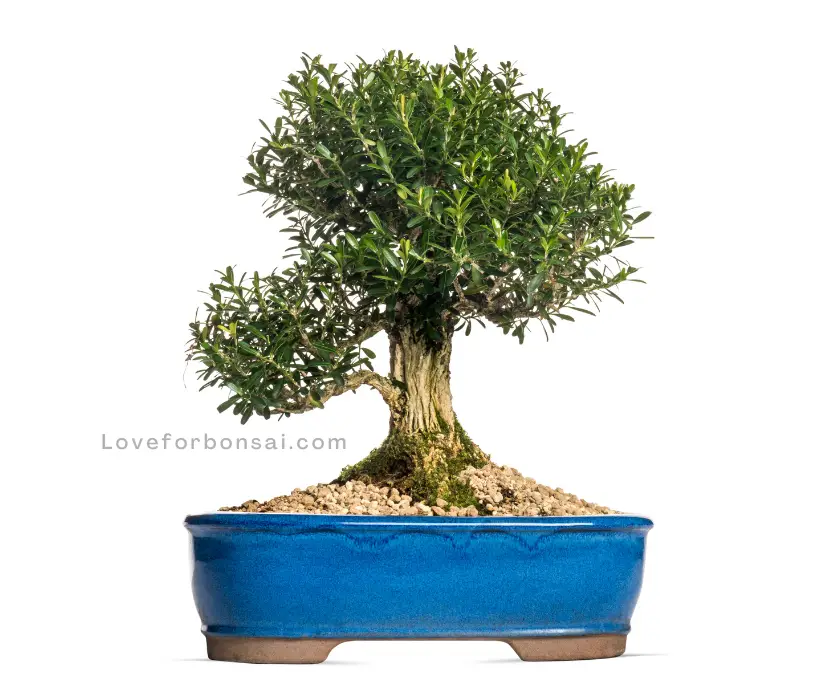Are you worried about your boxwood bonsai tree’s leaves turning yellow? Do you want to know what causes this problem and how to prevent it?
If so, you are not alone. Many bonsai enthusiasts face this issue and wonder how to keep their trees healthy and green.
In this blog post, we will explain the four main reasons why your boxwood bonsai leaves may turn yellow and what you can do to avoid them.
We will also share some tips on how to care for your boxwood bonsai and make it thrive. Read on to find out more!
So let’s get started…
Understanding the Causes of Yellowing Leaves in Boxwood Bonsai:
Here are some of the main causes of yellowing boxwood leaves
- Overwatering: The most common reason for yellowing leaves in boxwood bonsai is overwatering. When the roots are constantly soaked in water, they can become waterlogged, leading to root rot. This hinders the bonsai’s ability to absorb nutrients, causing the leaves to turn yellow. We’ll delve into proper watering techniques and how to strike the right balance.
- Lighting Issues: Boxwood bonsai trees thrive in bright, indirect light. Inadequate sunlight exposure can result in yellowing leaves and a weakened bonsai. We’ll discuss the ideal lighting conditions for your boxwood bonsai and how to ensure it receives sufficient light to promote healthy foliage.
- Nutrient Deficiencies: Nutrient deficiencies can manifest as yellowing leaves in boxwood bonsai. We’ll explore the essential nutrients your bonsai needs and how to identify and address any deficiencies that may be causing the yellowing.
- Pests and Diseases: Boxwoods are susceptible to various pests and diseases, which can cause the leaves to turn yellow. Common culprits include boxwood mites, leafminers, aphids, and fungal infections. We’ll guide you through identifying and combating these pests and diseases effectively.
How to Restore Vibrancy to Your Boxwood Bonsai:
Once you understand the basic reasons behind the yellowing of your boxwood bonsai it’s time to take action.
- Watering Tips: We’ll provide you with a step-by-step guide on how to water your boxwood bonsai correctly, considering the specific needs of the species and the season. You’ll learn the signs of overwatering and how to prevent waterlogged roots, allowing your bonsai to absorb the right amount of water and nutrients.
- Optimizing Lighting Conditions: Discover practical tips for providing adequate light to your boxwood bonsai, including suitable placement indoors and outdoors. We’ll discuss supplemental lighting options and how to strike the perfect balance between light and shade to promote healthy foliage.
- Nutrient Management: Learn about the essential nutrients required by boxwood bonsai and how to provide them through appropriate fertilization techniques. We’ll guide you on selecting the right fertilizers and establishing a feeding schedule to address any nutrient deficiencies causing yellowing leaves.
- Pest and Disease Control: Arm yourself with knowledge about common pests and diseases that affect boxwood bonsai. We’ll share preventive measures to protect your tree and effective treatments to combat existing infestations or infections. You’ll gain insight into organic and chemical control methods, as well as when to seek professional help.
Taking Care of Your Boxwood Bonsai
As you embark on this journey, enjoy the process of cultivating and tending to your miniature masterpiece. Here are a few additional tips to ensure the overall health and longevity of your boxwood bonsai:
- Pruning and Shaping: Regular pruning is essential for maintaining the desired shape and size of your boxwood bonsai. Prune back any dead or yellowing branches to encourage new growth. Additionally, shaping your bonsai through careful pruning will enhance its aesthetic appeal.
- Soil Considerations: Boxwood bonsai prefer well-draining soil to prevent waterlogged roots. A blend of well-draining bonsai soil, such as a mixture of akadama, pumice, and lava rock, is ideal for promoting healthy root growth. Avoid using regular garden soil, as it can compact and retain too much moisture.
- Temperature and Humidity: Boxwood bonsai thrive in temperate climates. They prefer temperatures between 50°F and 75°F (10°C – 24°C). Protect your bonsai from extreme heat or cold by providing adequate shelter or moving it indoors during extreme weather conditions. Maintaining moderate humidity levels will also benefit your tree.
- Seasonal Care: Boxwood bonsai may display seasonal changes, such as browning or yellowing leaves during winter dormancy. This is a natural occurrence and not necessarily a cause for concern. Adjust your care routine accordingly, providing the necessary winter protection and adjusting watering frequency during dormant periods.
- Monitoring and Observation: Regularly inspect your boxwood bonsai for any signs of stress, pests, or diseases. Early detection is crucial for effective treatment. Observe the overall health of the tree, including leaf color, texture, and new growth. This will help you identify any potential issues and address them promptly.
Read the full article about how to care for your boxwood bonsai
Final Thoughts:
We hope you enjoyed this blog post and learned something new about why your boxwood bonsai leaves may turn yellow. As you can see, there are many factors that can affect the health and color of your tree, such as water, light, temperature, pests and diseases.
By following the advice we gave you, you can prevent most of these problems and keep your boxwood bonsai happy and green. If you liked this post, please share it with your friends and fellow bonsai lovers.
You can also explore more articles on our site about different types of bonsai trees and how to care for them. And finally, don’t forget to take action and apply what you learned today to your own boxwood bonsai. You will be amazed by the results!
